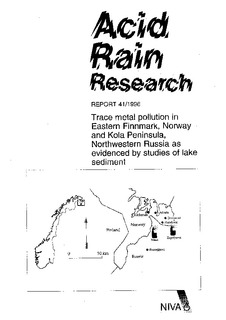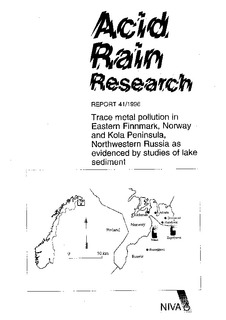| dc.contributor.author | Traaen, T. | nb_NO |
| dc.contributor.author | Norton, S. | nb_NO |
| dc.contributor.author | Appleby, A. | nb_NO |
| dc.contributor.author | Peter G. | nb_NO |
| dc.contributor.author | Dauvalter, V. | nb_NO |
| dc.contributor.other | Traaen, T. - Project manager | nb_NO |
| dc.coverage.spatial | Finnmark | nb_NO |
| dc.coverage.spatial | Finnmark og Kola | nb_NO |
| dc.date.accessioned | 2014-08-01T10:39:26Z | |
| dc.date.available | 2014-08-01T10:39:26Z | |
| dc.date.issued | 1996 | nb_NO |
| dc.identifier | 3465 | nb_NO |
| dc.identifier.isbn | 82-577-3003-3 | nb_NO |
| dc.identifier.issn | 1894-7948 | nb_NO |
| dc.identifier.uri | http://hdl.handle.net/11250/208850 | |
| dc.description.abstract | Piston sediment cores from Lakes Hundvatn (eastern Finnmark, Norway) and Shuonijârvi (northwestern Russia) in March 1993 were dated with 210 Pb. Sedimentation rates at Hundvatn are 1.9+0.3 mg cm² y1 (0.028 cm y1) below a sediment depth of 4.0 cm and 4.0 mg cm² y 1 above in Shuonijârvi the rate is 2.4 mg cm² y 1 (0.032 cm y 1) over the last 170 years. Cs isotopes from thermonuclear bomb fallout have been redistributed through the core, rendering them useless for dating using 137 Cs. 134 Cs (from Chernobyl) was detected in Shuonijârvi sediment. 241 Am distribution in the sediment is consistent with the 210 Pb chronology. Concentrations and fluxes of Cd, Co, Cu, Ni, Pb, and Zn increase within the last century. All the fluxes except that of Pb are higher to the northeast of the Nikel and, in combination with data from Dauvalter (1994), indicate that smelters of the Pechenga-Nikel Company have been a major source of metal pollution since their start-up and the effects are at a maximum in the youngest sediment, representing approximately the last ten years of sedimentation (up to 1993). No regional pollution of the metals (except Pb) is evident in sediment prior to the 20th century. However, the histories of Pb fluxes and concentrations indicate a pollution history probably in excess of 2000 years. | nb_NO |
| dc.description.sponsorship | Statens forurensningstilsyn (SFT) Norsk institutt for vannforskning (NIVA) | nb_NO |
| dc.publisher | Norsk institutt for vannforskning | nb_NO |
| dc.relation.ispartofseries | NIVA-rapport;3465 | nb_NO |
| dc.rights | Navngivelse-IkkeKommersiell-DelPåSammeVilkår 3.0 Norge | nb_NO |
| dc.rights.uri | http://creativecommons.org/licenses/by-nc-sa/3.0/no/ | nb_NO |
| dc.subject | sur nedbør | nb_NO |
| dc.title | Trace metal pollution in Eastern Finnmark, Norway and Kola Peninsula, Northwestern Russia as evidenced by studies of lake sediment | nb_NO |
| dc.type | Research report | nb_NO |
| dc.rights.holder | Norsk institutt for vannforskning/Norwegian institute for water research | nb_NO |
| dc.subject.nsi | VDP::Matematikk og naturvitenskap: 400 | nb_NO |
| dc.source.pagenumber | 18 | nb_NO |
| dc.subject.keyword | innsjøsedimenter | nb_NO |
| dc.subject.keyword | tungmetall | nb_NO |
| dc.subject.keyword | datering av sedimenter forurensningshistorie | nb_NO |
| dc.subject.keyword | heavy metals | nb_NO |
| dc.subject.keyword | lake | nb_NO |
| dc.subject.keyword | sediments | nb_NO |
| dc.subject.keyword | sediment | nb_NO |
| dc.subject.keyword | dating | nb_NO |
| dc.subject.keyword | pollution | nb_NO |
| dc.subject.keyword | history | nb_NO |
| dc.relation.project | O-89187 | nb_NO |


